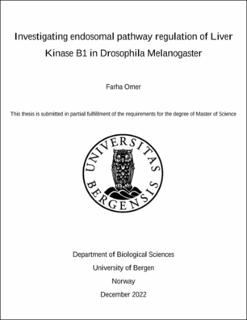| dc.description.abstract | Within a cell, efficient intracellular trafficking is essential for various functions, including cellular polarity, cell signalling, and maintenance of homeostasis by regulation of cellular energy. Liver kinase B1 (LKB1), also known as Stk11 is a gene that acts as an indirect regulator of these biochemical processes by interacting with key endosomal trafficking regulators, such as CIII-PI3K and Rab GTPases which are implicated in various diseases, including cancer. LKB1 is found to be mutated in an autosomal recessive disorder known as Peutz Jeghers Syndrome (PJS), a disease associated with increased risk of development of cancer. The gene was first identified as a tumor suppressor due to its role in controlling bioenergetics, cell growth and several biochemical functions, but it was later suggested that it could also promote tumor progression by promoting cell survival, calling it a contextual oncogene. In cells in culture, LKB1 is transported from the nucleus to the cytosol where it is active in a heterotrimeric complex with MO25 and STRADα. The interaction of LKB1 with its downstream target called AMP-activated protein kinase (AMPK), also regulated by the endo-lysosomal pathway, is crucial in the context of promoting cell survival under conditions of energy stress. Preliminary studies suggest that LKB1 localizes on the (lateral) plasma membrane, in vivo and in polarised cells from where it may be endocytosed, however, the pathway and destination of the protein is not known, in terms of whether it is sorted, recycled, or degraded in the lysosome. For the purpose of our study, we used Drosophila genetics, structural prediction modelling, high-resolution imaging techniques and statistical analysis to show that LKB1 activity levels and localization are essential for epithelial integrity. We constructed recombinant fly lines with GAL4 driver and UAS-tagged gene expression within a domain of the developing wing epithelial tissue to show that localization and activity of endogenously expressed GFP-tagged LKB1 is affected as a result of knockdown of important trafficking regulators, such as vps34, the catalytic domain of CIII-PI3K, generating PI3P, and WDFY2 a PI3P binding protein. In order to accomplish this different LKB1 versions and quantification methods were evaluated with an aim to establish a method to measure and distinguish between the levels of LKB1 in cytoplasm and in close proximity to the plasma membrane. In addition, we blocked insulin signalling in order to investigate the interplay between starvation induced autophagy and LKB1 regulation. | |
